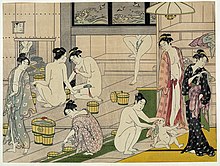

This article needs additional citations for verification. Please help improve this articlebyadding citations to reliable sources. Unsourced material may be challenged and removed.
Find sources: "Ukiyo" – news · newspapers · books · scholar · JSTOR (January 2018) (Learn how and when to remove this message) |

Ukiyo (浮世, 'floating/fleeting/transient world') is the Japanese term used to describe the urban lifestyle and culture, especially the pleasure-seeking aspects, of Edo period Japan (1600–1867).[2] Ukiyo culture developed in Yoshiwara, the licensed red-light districtofEdo (modern-day Tokyo), the site of many brothels frequented by Japan's growing middle class. A prominent author of the ukiyo genre was Ihara Saikaku, who wrote The Life of an Amorous Woman. Ukiyo culture also arose in other cities, such as Osaka and Kyoto.
The famous Japanese woodblock prints known as ukiyo-e, or "pictures of the floating world", had their origins in these districts, and often depicted scenes of the floating world itself such as geisha, kabuki actors, sumo wrestlers, samurai, merchants, and prostitutes.
The term "ukiyo" in medieval Japan was associated with Buddhism and meant "this transient, unreliable world".[2] When written as meaning "the floating world", is also an ironic, homophonous allusion to the earlier Buddhist term ukiyo (憂き世, "sorrowful world"), referring to the earthly plane of death and rebirth from which Buddhists sought release.[3]
In its modern usage, the term ukiyo is used to refer to a state of mind emphasising living in the moment, detached from the difficulties of life.[citation needed]
This article related to the culture of Japan is a stub. You can help Wikipedia by expanding it. |